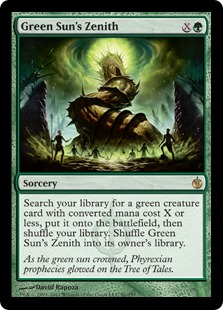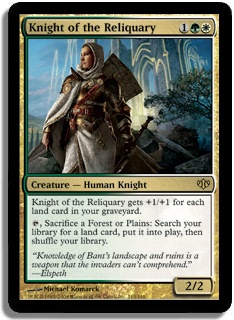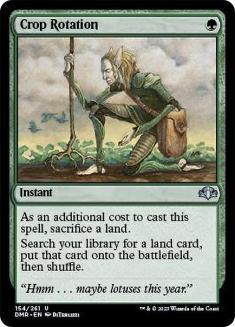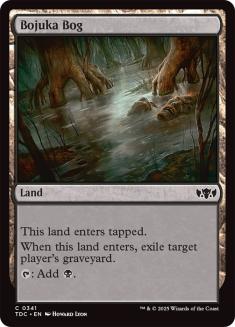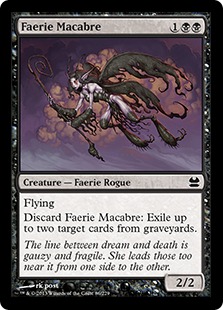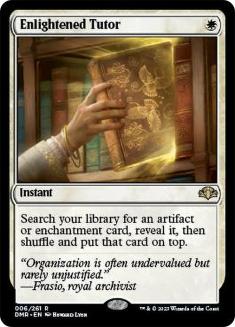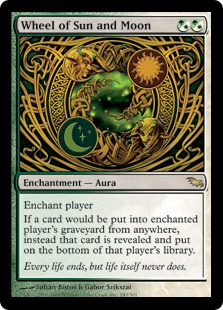Trust.
It is the backbone of every relationship. Building trust allows you to create and maintain bonds of friendship, respect, and admiration. Without trust, every interaction with another person would be meaningless, as it would mean living in constant fear. Without trust, who would protect us when we are vulnerable? Who would help us when we are unable to overcome an obstacle?
Trust is the foundation of everything!
I trust you to read this and to learn from this. Week in and week out, I pour myself into my writing in an attempt to teach, an attempt to extend a hand of camaraderie. I pour myself into my work because I love it, but the cycle of trust goes both ways.
You trust me to be right in my analysis of decks and information. You come with open ears and open hearts, yearning for something more than just decklists (I hope). You come to me because you trust me to be honest with you, regardless of the outcome. And that, in essence, is all I have to give: my honesty. And that is all I ask of you in return.
Each week, I tell you what I think is good and what is correct to play. I put my money where my mouth is when I think I’m right, and I play my heart out at every tournament I attend. Whether I’m doing my best to inspire or just to prove something to myself, I want my words to carry weight. Without success, these words would feel hollow and fall on deaf ears. I don’t want to be some false idol, but I’m also learning just as much as you every single time I play a game of Magic. I learn something new every time I touch this keyboard and begin to write. I learn something about myself that I didn’t know before, something I can use to make myself better. When my fingers touch the keys, I just start typing and don’t stop for hours upon hours, because I love it.
It’s refreshing.
While I occasionally use this article series as a means to vent my frustrations, I also use each written piece as a building block to try to fit myself back together. I’m scattered in a thousand different pieces in a thousand different places, and each week I sit down and spend a night collecting those pieces and trying to put them back together. Each time I try to make the picture look a little bit more like what I want to be, what I want to look like and feel like. Each week I break myself apart so that I can build myself back up, and I’m glad to have you to tag along for the ride.
Your support, kind words, and interest are what keep me going. You are the fuel that keeps my fire burning, and your hungry minds are what drive me to write and teach. Growing up, I always felt comfort when others confided in me and trusted me to help them. When I showed one of my classmates how to solve a math problem or when I explained the motive behind a short story, their eyes would light up. That is what I live for. Â
An audience can be inspiring.
Thank you.
…
Now on to the good stuff!
This week we’ll be discussing Legacy. I haven’t talked much about the format in quite a while, but I’ve played a few Legacy tournaments recently with one of my all-time favorite decks, so I have some ideas to share with you that I trust that you will enjoy.
Well, if the subject matter is in question, then let me inform you. The deck I’ve been working on lately for Legacy is…
Maverick!
(Big shocker, right?)
Before we get started, here is my current list (though it’s constantly in flux):
Creatures (23)
- 4 Mother of Runes
- 1 Scryb Ranger
- 1 Gaddock Teeg
- 4 Noble Hierarch
- 4 Knight of the Reliquary
- 2 Qasali Pridemage
- 1 Fauna Shaman
- 2 Scavenging Ooze
- 4 Thalia, Guardian of Thraben
Planeswalkers (1)
Lands (24)
Spells (12)

I know the deck is chock full of one-ofs, but they all have a job to do. Let me explain.
I will say this about Legacy: people love to play whatever they want to play! Unlike Standard, Legacy is rarely dictated by metagamesand recent tournament results. Just look at the last Legacy Grand Prix in Europe. It was won by Storm, and virtually no one on this side of the pond is a fan of Storm!Â
In Legacy, this inherent need to brew is amplified tremendously. People have pet decks. People have crazy concoctions. People bring the decks they’ve played for years to the nearest Legacy tournament and will defend their turf to the last person! Truly, it is the only format I’ve seen where you can literally play whatever brew you want to play, as long as your brew does something powerful, has a decent disruption package, or has solid plans against the format’s best decks.
Here’s the trick:
Build your deck to beat certain cards, not decks.
Legacy is too full of different archetypes to disrupt all of them. Some people are dead to Ancient Grudge, while others fold to Stifle. Some people are even dead to a single Karakas! You can’t beat everything, but you can build your deck in such a way that you can ignore some strategies while absolutely punishing others.
Since you can’t plan for everything, you need to be versatile. You have to attack from an angle that they won’t expect or create situations where there is no way for your opponent to win. This can be done a variety of ways using a plethora of cards, but a coherent strategy is key. You need to be streamlined, focused on what you’re trying to do, and knowledgeable of the other cards in the format that you need to beat.
Maverick is very good at doing most of these things. Certain cards throughout Magic’s history are potent for disrupting multiple strategies, and a lot of them happen to be white and green! This is perfect for Maverick since the deck is made up primarily of those two colors. While Maverick can be built in a variety of ways, such as opting to splash Grove of the Burnwillows and Punishing Fire or playing Geist of Saint Traft and Spell Pierce, green and white remain the backbone of the deck.
Regardless of the color(s) you want to add to the deck or if you’re a purist and don’t want to tamper with a solid mana base, Maverick does a few things very well.
This is the heart of the deck. Green Sun’s Zenith gives the Maverick player the ability to search for any utility creature at points in the game where that creature is most relevant. During the early turns of the game, if you’re short on mana sources having the ability to turn Green Sun’s Zenith into Llanowar Elf via Dryad Arbor is just absurd. If you are light on mana and also need access to white or blue, you have the ability to grab Noble Hierarch.
As the game progresses, your Tutor targets grow rapidly. Cards like Gaddock Teeg can singlehandedly cripple certain archetypes, and even a lowly Scryb Ranger will allow you to generate much more mana than you normally would have thanks to untapping your Noble Hierarch. Searching up a Fauna Shaman so that you can turn every redundant Noble Hierarch into a bigger threat can be valuable as well!
But the single, most powerful thing about Green Sun’s Zenith is that it is always the best creature to draw in virtually any situation, given that you have to have just one extra mana to pay for it. You get to play an additional four copies of any creature in your deck, and you get to draw them in the situations where they would be most useful!
You also get to play four extra copies of this beefy fellow:
Knight of the Reliquary is the best card in the deck. Sure, in a vacuum you can make all sorts of arguments for different cards being the best card in the deck, but my vote is Knight. After all, in a vacuum you don’t have any creatures for Green Sun’s Zenith to fetch, right? If you don’t look at cards in context, then you shouldn’t bother looking at them at all. Context is all that Magic is and all it should be. Certain cards gain or lose value based on so many different factors that ignoring context is just asinine.
What Knight of the Reliquary does is give us a threat that also doubles as a utility creature. It can fetch Wasteland and put our opponent behind on resources. It can search up Maze of Ith and stall our opponent’s Delver of Secrets / Insectile Aberration. It can even draw a card with Horizon Canopy, helping you dig desperately for that Swords to Plowshares. Knight of the Reliquary is also gigantic. Like Brienne of Tarth. We’re talking Stay Puft Marshmallow Man; the dude’s big.
You get the picture.
While Knight of the Reliquary is usually the biggest creature in play, it can occasionally have the trouble of being blockable. This little issue is generally solved by Mother of Runes, but there really aren’t that many creatures that see play in Legacy, so Abyssing your opponent every turn is generally enough to get the job done eventually.
What makes Maverick so good against the format’s more popular decks? Well, for one, Legacy mana bases are generally atrocious. Greed is the name of the game, and that makes Wasteland one of the best cards in the format. People have been adapting recently to play more basic lands, but any three-color deck is going to get annihilated by Wasteland, especially so if you’re searching them up with Knight of the Reliquary.
But every deck can play Wasteland, right?
Sure, but not every deck can use Wasteland effectively. Many control decks use Wasteland as a defensive measure to protect themselves from opposing annoyances like Mutavault, but those decks aren’t using Wasteland on the same level. The decks that use Wasteland the best can apply a substantial amount of pressure or create some form of inevitability through recursion. RUG Delver is the best aggressive Wasteland deck, while BUG Control with Life from the Loam is often heralded as the best Wasteland control deck. Maverick can generate some middle ground between the two and uses Knight of the Reliquary (and sometimes Life from the Loam) to create inevitability, but it can turn the corner and be aggressive at the drop of a hat.
While Wasteland is awesome, I think that the deck has a lot of other things going for it. There are a lot of decks that aren’t vulnerable to Wasteland or that can shrug it off with little trouble. These decks are often harder to combat, but you have a lot of awesome tools at your disposal!
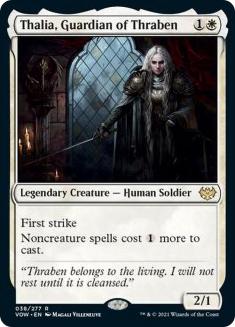

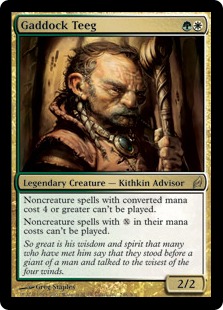
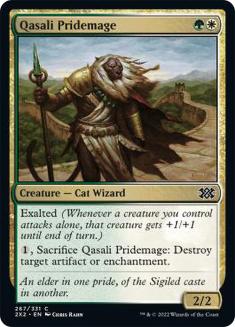
These four creatures are what give you a fighting chance against unfair decks! Since you aren’t playing blue (most of the time), you need your threats to double as disruptive elements. We’ll talk about each one of these threats and why they are essential to the strategy:
1) Thalia, Guardian of Thraben: Thalia is amazing against most of the format. She will dominate many combo decks and can often end the game on the spot against a deck like Storm. While her ability forces you into a pigeonhole of sorts in deckbuilding, you will find that her effect is generally much more devastating to the opponent. Building your deck to make Thalia less painful is always a plus.
While Thalia doesn’t always get the job done by herself, she can flat-out brick an opponent when you combine her with Wasteland. With mana acceleration of your own, her effects should hurt you less than your opponent, but just be careful when deciding how to play out your turns. You don’t want to run her into a Daze against RUG Delver, but you also don’t want your Green Sun’s Zenith getting stuck in your hand (or being much worse).
2) Scavenging Ooze: Along with Thalia, this creature is a fairly new addition to the archetype, but one that has given the deck new life. Many decks in Legacy generate an advantage through graveyard use, and even Maverick is no different. Access to Scavenging Ooze will allow you to win fights against those archetypes because it will keep their problematic cards in check. If you can stick it early enough against Dredge or Reanimator, the game should be mostly over.
Against decks like RUG Delver, you can keep their Nimble Mongoose or Tarmogoyf from getting out of hand while also growing your Ooze and gaining life in the process. Against decks with Lightning Bolt as the primary removal, both of these effects are helpful!
3) Qasali Pridemage: While I haven’t really liked Qasali Pridemage as much as of late, I do think it is still a necessary inclusion. Two has currently felt like the right number, but a lot of different decks will present you with must-kill artifacts or enchantments. Having access to Green Sun’s Zenith to fight these decks is just icing.
The additional boost in combat due to exalted is also a pretty sweet bonus!
4) Gaddock Teeg: While he didn’t see much play over the last few months and a lot of people have cut him entirely from the deck, I’m under the impression that he is more necessary than ever. While Magic Online isn’t the end-all/be-all for Legacy, the U/W Control deck has completely dominated the format. Gaddock Teeg (and a way to protect it) is how you beat them, and few other cards matter! Their biggest threats to you are Terminus and Jace, the Mind Sculptor, and Gaddock Teeg singlehandedly shuts down both of those angles of attack.
While most of those decks have spot removal to kill Teeg, you get Mother of Runes and (sometimes) Sylvan Safekeeper to keep him alive and off the farm.
…
But Maverick is an intricate machine, and most of the parts can be altered or changed in order to be more successful against certain decks or archetypes. You can also have a wildly drastic sideboard to combat some of the odd strategies that pop up here and there, or you can just focus on a few key matchups and hope to destroy them.
This is where cards like Fauna Shaman, Enlightened Tutor, Crop Rotation, and Green Sun’s Zenith really shine! When you are able to play small Tutor packages throughout your deck, it is insanely difficult for your opponent to fight you. Red mages have to deal with a singleton Spike Feeder as well as Enlightened Tutor for Warmth; good luck with that! Ad Nauseam opponents have to beat Thalia, Gaddock Teeg, and Enlightened Tutor for Ethersworn Canonist.
You see where this is going.
After sideboarding, you have plenty of cards that can be exchanged for a set of other more specific hate cards. Enlightened Tutor can help exacerbate this problem for the opponent since the decks that are vulnerable to the hate rarely have ways to deal with those hate cards. This means you don’t actually need to have more than one copy of said hate card, but having two extra virtual copies thanks to Enlightened Tutor can be lifesaving.
While I don’t always recommend Enlightened Tutor sideboards for Maverick, I think they are well positioned at the moment. There are so many different strategies that it is hard to fight off all of them, so I prefer to have a slew of singletons and Tutors to make their life difficult. For example, how is Dredge supposed to Cabal Therapy you when this is your sideboard plan?
And this isn’t even including Scavenging Ooze!
In the end, I think all you really need to do is know your enemy and know what cards are most important for your deck against them. When you figure this out, then you should be fine. At the moment, there are only a handful of nonland cards that should be maxed out in your deck, and those are limited to Noble Hierarch, Knight of the Reliquary, and Green Sun’s Zenith. You should judge all of the other cards in the deck based on their efficiency, standalone strength, and overall utility in the format. If they aren’t living up to their potential, don’t be afraid to trim something or even cut it from the deck entirely!
Play the deck for yourself. Tune it to fit your style. Crush your enemies. It’s as simple as that!
I really have an unhealthy love for this deck, but I think that is mostly due to my play style and the cards I love to cast. Green has always been at the top of my all-time favorite colors, and I love it when it gets to do things that are very blue-esque. Green Sun’s Zenith and Knight of the Reliquary allow for some deep games since you are constantly making difficult decisions, and I love having a really complex puzzle to figure out!
…
If you haven’t noticed, I’ve been helping produce some really awesome playtest videos with help from Brian Braun-Duin. Last Friday, we featured Maverick versus RUG Delver, and you can check it out here. This should help give you an idea of how the deck plays and what you can expect. Check it out, and leave us some feedback if you like what we’re doing (and even if you don’t!). We’d love to hear your ideas for improvement so that we can produce the best videos possible.
This Friday’s video will feature commentary over the match so that there is less free information given during game play. If you are a fan, please let us know so we can continue to bring you more of what you love to see!
Thank you guys for everything. For the support. For the love. And for the trust. And most of all…
Thanks for reading.
strong sad on Magic Online
Follow me on Twitter @strong_sad

